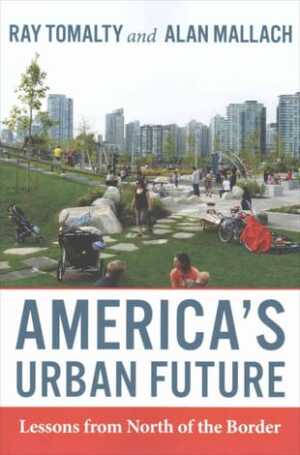America’s Urban Future: Lessons from North of the Border
Ray Tomalty and Alan Mallach
Island Press
2000 M Street NW, Suite 650, Washington, DC 20036;
www.islandpress.org.
312 pages. Paperback, $40.
According to authors Ray Tomalty and Alan Mallach, U.S. cities should look to Canada for ways to make our urban areas more livable and sustainable. Canadian metropolitan regions are often more compact, more energy-efficient, and more transit-oriented, with more vital central cities and more effective urban regeneration. The authors believe that these outcomes result from Canadian legal and fiscal structures, as well as from public policies.
This book offers a near-perfect pair of authors to compare U.S. and Canadian planning and urban policy outcomes. Tomalty is a principal of Smart Cities Research Service, based in Montreal, and an adjunct professor at McGill University’s School of Urban Planning. Mallach is a senior fellow at the Center for Community Progress in Washington, D.C., and the former director of housing and economic development for Trenton, New Jersey. Together, they have conducted extensive urban livability research on both sides of the border.
Their ideal of a livable urban region is “one in which all residents can enjoy a decent quality of life and can find opportunity, without regard to their income, family status, or where they fit into the spatial system.” They acknowledge that no region fully meets this high test, but find that those in the United States fall “appalling short,” given our resources as a nation. To understand why this shortfall occurs, they concentrate on issues of urban form and transportation. Their book offers excellent coverage of these issues, including many metrics and comparative case studies.
For example, compare Seattle and Vancouver. Both are medium-sized coastal regions with rapid 21st-century growth rates (13 percent for Seattle and 16 percent for Vancouver) and central cities of just over 600,000 residents. However, Vancouver’s regional population density is two and a half times as great (120 versus 47 people per square mile), with much less single-family housing (34 percent versus 60 percent) and a transit network more than five times as dense offering almost twice the level of service per capita. Resulting greenhouse gas and particulate emissions are lower in Vancouver, along with much higher modal shares of walking and cycling.
These differences result from Canada’s stronger regional institutions with their broad powers to influence development patterns, coordinate land use and transportation planning, and require higher densities. Metro Vancouver is a bottom-up regional district with 21 municipal partners. Decisions are made by the district board based on voluntary cooperation among member municipalities within a provincial legislative framework, a “strategy of gentle imposition.” Metropolitan Seattle is a member of the four-county Puget Sound Regional Council, which is guided by the broad goals of the Washington State Growth Management Act.
The differences are also due to a longer history of serious planning. Metro Vancouver adopted its first regional plan in 1975 and has maintained a consistent planning vision based on improved transit and reduced car use, growth concentrated in the metropolitan core and town centers, and a regional greenbelt. Despite often-contentious debate, “excruciatingly” slow decisions, and “sky-high” housing prices, the regional system has placed 75 percent of area growth into built-up areas and generated high transit ridership.
In contrast, most U.S. state and regional planning and governance institutions are relatively recent and weak. By design, they have little power to manage growth to stem sprawl and to provide transportation systems that limit car use. Instead, their voluntary regional associations contain dozens of autonomous local governments, with each municipality adopting its own master plan and zoning ordinance with few regional or statewide constraints. Local turf protection outweighs regional advantages.
If the United States wants to increase the performance of its urban regions, then it needs to heed the bottom-line lessons from north of the border: “A framework in which infrastructure investment strategies are decided at the regional level and where local planning is accountable to regional or provincial-level bodies . . . is significantly more likely to foster growth patterns that are sensitive to larger transportation, energy use, and environmental considerations.”
U.S. regions also need to employ effective policy tools. In Canada, leapfrog development and urban sprawl are contained by urban growth boundaries and agricultural land reserves. Social equity is enhanced by fiscal redistribution among central cities and suburbs. Provincial education funding prevents problems of schools in low-income school districts facing inadequate budgets and low teacher pay.
It is hard to argue with the evidence presented by Tomalty and Mallach. They show that on every important indicator, the percentage of Canadians in social or economic distress—poverty, housing, or education—is significantly lower than in the United States, even though it remains a wealthier nation.
Could these policy reforms be enacted in the States? The authors are realists, acknowledging that U.S. national political, legal, and physical differences limit the extent to which meaningful policy change is currently feasible and make it difficult to overcome the present antigovernment tide in Washington and many state capitals.
But they are also optimists, arguing that the move back to the central cities that is transforming the centers of formerly car-dependent places, like Los Angeles and Houston, into higher-density, mixed-use places is a powerful, bottom-up force for change. They are hopeful that “guerilla action” by developers, advocates, and scattered state and local governments, along with a new generation of citizens voting for cities with their feet, will force federal and state policy to catch up with movement on the ground. That would indeed presage a brighter American urban future.
David R. Godschalk is planning professor emeritus at the University of North Carolina at Chapel Hill and coauthor of Sustaining Places: Best Practices for Comprehensive Plans (APA Planning Advisory Service, 2015).





